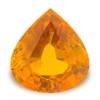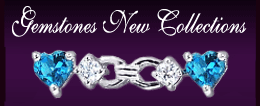Glittering Stones » Gemstone Reports » International Gemological Institute Report (IGI)
Welcome To IGI Diamond Grading Report
IGI Expertise and Technology Meeting the Requirements of Today.
While two gems may look identical to the untrained eye, they may be quite different in quality and worlds apart in value. Thus, scientific analysis and certification of your stones by an independent, unbiased organization like IGI is of the utmost importance.
 IGI Diamond Reports Jewelry Reports are used and recognized worldwide as authoritative documentation of the authenticity, grade and identification of your stones.
IGI Diamond Reports Jewelry Reports are used and recognized worldwide as authoritative documentation of the authenticity, grade and identification of your stones.
The information contained in every IGI is also stored in our computer databank, ensuring that you may at any time request and receive an update of your reports if the need arises.
Essentials of 4 C’s :
Because diamonds are so valuable, it’s essential for industry professionals to have a universal grading system when comparing diamond quality. In the mid-twentieth century, GIA developed the International Diamond Grading System™ and the 4Cs as a way to objectively compare and evaluate diamonds.
The Four Cs of diamond quality will give you a multitude of information about a diamond’s characteristics and value, but they can’t begin to describe one elusive quality – beauty. To do that, you’ll need to experience the diamond with your own eyes.
Carat :
Diamonds weight or size is measured in carats (ct.). A carat is 0.2 grams and there are 100 points (or 200 milligrams) per carat. With an accuracy of 1/100,000 ct, the IGI scales provide a highly precious diamond weight and this weight is specified on the Diamond Report to two decimal points.

Measuring Carat Weight :
Before a diamond enters the GIA Laboratory for grading, it is labeled with a unique internal identification number used to distinguish and track it through processing. At this point, client information is removed from the diamond packaging, and the diamond proceeds to its first stop –the Weights and Measures Department.
Here, the diamond is weighed using a very accurate electronic micro-balance that captures the weight to the fifth decimal place. An optical measuring device is used to determine the diamond’s proportions, measurements and facet angles. This data is uploaded into Horizon, GIA’s operations and information management system.

After weighing and measuring, the diamond is placed into a transparent storage case that is labeled with its internal ID number, weight, measurements and requested services. When applicable, the diamond’s unique GIA Report Number is also assigned at this time.
Screening and Advanced Testing for Diamond Identification and Color Origin :
Next, the diamond undergoes a technical screening process to determine if it is potentially synthetic, high pressure/high temperature (HPHT) processed, or a diamond simulant. If further screening is required, advanced testing is performed by the Identification Services department using state-of-the-art technology such as Fourier transform infrared spectrometry (FTIR) and Raman spectroscopy to determine the item’s identity and color origin. These tests are also performed on all items submitted for colored diamond services. Bottom line, this is where it is natural and of natural color or evidence to the contrary is revealed.
Inscription :
At the client's request, a diamond may be microscopically inscribed on its girdle with its unique GIA Report Number (referred to as the GIA Inscription Registry), a personal message, or other text, symbols or logos. An inscription allows for easy identification of a diamond, a way to personalize the diamond, or serves as a form of branding for the diamond manufacturer or retailer
Color :
Most diamonds of gem quality vary in shade from colorless to yellow.
To determine the correct color, all submitted diamonds are compared to an internationally accepted master set of stones, the color of which ranges from D, or colorless (the most sought after) to Z, the yellowest.

Other colors occur in diamonds such as brown, orange, pink, blue, etc. The most intense of these shades are determined as "Fancy" colors and referenced on the IGI Diamond Report.

Grading Color :
Since light source and background can have a significant impact on the appearance of color, the diamond's color is graded in a standardized viewing environment. A minimum of two color graders enter their independent opinions into the system. During this phase, the second grader is not privy to the opinions of the first. Depending on the agreement of these opinions, and the weight and quality of the diamond, it may be sent to additional graders who enter independent color opinions. The color grade is determined when there are sufficient agreeing opinions.
Clarity :
In order to grade the clarity of a diamond, it is necessary to observe the number and nature of any internal characteristics in the stone as well as their size and position.
This Diamond Clarity Grading is carried out using the IGI scope and a loupe 10x under the experienced eye of laboratory gemologists. A diamond is said to be "Internally Flawless" when it presents no internal defects under 10 x magnifications.

Grading Clarity and Finish :
Clarity is graded with 10x magnification under standard viewing conditions. The preliminary grader carefully and thoroughly examines the diamond in order to locate and identify clarity/finish characteristics and evidence of any diamond treatments, such as fracture filling or laser drilling.

The preliminary grader assigns an opinion of the diamond’s clarity, polish and symmetry, then plots necessary clarity characteristics on the diagram most representative of the diamond’s shape and faceting style, which is selected from a database of hundreds of digitally stored diagrams.
During this step, the grader verifies all previously captured weight and measurement data and assigns written descriptions of the diamond’s culet and girdle thickness. For a round brilliant cut diamond, this measurement data, along with polish and symmetry assessments, is used to determine its GIA Cut Grade. Additional steps are also taken during this grading process, and all others, to check and double check for indicators of known diamond treatments and synthetics.
A second grader then carefully and thoroughly examines the diamond to locate and identify clarity/finish characteristics and, again, the presence of any diamond treatments. This grader performs all the grading steps done by the previous grader and then enters his / her own independent clarity / polish / symmetry opinions.
Depending on the diamond’s weight, quality, and the agreement of grading opinions, additional quality assurance process steps are also performed. More experienced staff gemologists may review all of the previous grading information and render independent clarity / polish / symmetry opinions. Grading results are finalized once there are sufficient agreeing opinions.
Cuts :

How a diamond has been cut, polished, and to what proportions and symmetry, are of utmost importance since these factors determine the life, brilliance and dispersion of the diamond. If these cutting factors fall below standard, the appearance of the diamond will be adversely affected.
Grading Cut :

After the color and clarity grading process, the diamond’s proportions (measurements and facet angles), along with its polish and symmetry descriptions, are used to determine its GIA Cut Grade. A diamond’s brightness, fire, scintillation (sparkle and pattern), weight ratio, and durability, as well as polish and symmetry, are all considered within this final assessment of cut quality.
Shapes :
| Pear
Variation of the brilliant cut with a pear-shaped girdle outline and 56 to 58 facets. Also called pendulous or teardrop. |
 |
| Emerald
Rectangular or square step cut with diagonally cut corners and two, three, or four rows of facets parallel to the girdle on the crown and pavilion. It is frequently used to fashion emeralds. If the shape is square, it is called a square emerald cut. |
 |
| Heart
Modified brilliant cut in the shape of a heart, with a table, 32 crown facets, 24 pavilion facets, and a shield-shaped culet. |
 |
| Marquise
Elongated, boat-shaped brilliant cut with curving sides and pointed ends, developed in France in the 1740s. Believed to have been named after the Marquise de Pompadour, a mistress of King Louis XV. Also called Nanette. |
 |
| Oval
Brilliant cut with an elliptical girdle outline; also called an oval brilliant cut. Obsolete barrel-shaped cut, circular in section and covered with triangular facets. |
 |
| Princess
popular square or rectangular modified brilliant cut usually with 57 facets (21 crown facets, 32 pavilion facets, and four girdle facets) but occasionally a rectangular or square brilliant with 144 facets. Many variations are on the market. |
 |
NOVEMBER BIRTHSTONE - CITRINE

COMMEMORATIVE EVENT - 13th Anniversary
KEYWORDS - Success, Abundance, Personal Power
ALSO KNOWN AS - Merchant's stone, Success stone
COLORS - Pale yellow to brown
OCCURRENCE - Brazil
COLOR ZONING - Tiger stripes or Zebra stripes


